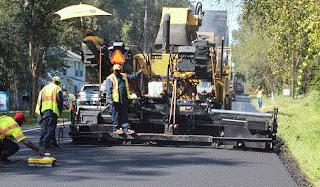 |
| Paving a road |
It doesn't take much research to learn how roads are funded; but here's how Indiana, the state where I live, does this (and it's pretty much the same in every state):
New roads and streets as well as major repair projects are funded by a combination of federal funds, monies budgeted from the state general fund, and (in some cases) issuing municipal bonds. The general fund receives gasoline and road use taxes as well as registration and title fees. Unlike most states, Indiana also charges sales tax on gasoline; which also ends up somewhere in the general fund.
When street repairs and infrastructure projects are called for, the state contributes funds on a sliding scale. In the case of smaller towns and low-population counties, the state's share is 80%; for larger cities and counties, the state foots 50% of the costs. The local jurisdiction covers the rest of the bill.
Because Indiana does not have local sales taxes, revenue to city and county jurisdictions arises from two sources: county income taxes and property taxes. Whether they own a motor vehicle or not, cyclists pay property taxes (either directly or as a portion of rent) and most also pay personal income tax. That's not to mention their contribution to local businesses that pay both of those taxes and then pass the costs on to customers.
A local official recently said that can cost as much as one million dollars per mile to repave a street that's been damaged by weather and traffic. A bicycle's contribution to that damage is vanishingly small. On that basis alone, you could make the case that cyclists actually pay more than their share of road maintenance costs.
Not that the haters would believe you, of course...
copyright © 2023 scmrak
No comments:
Post a Comment